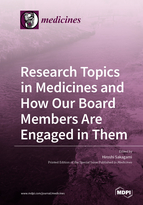Research Topics in Medicines and How Our Board Members Are Engaged in Them
A special issue of Medicines (ISSN 2305-6320).
Deadline for manuscript submissions: closed (31 July 2020) | Viewed by 142145
Special Issue Editor
Interests: informatics; information network; pharmacy; biological pharmacy; basic medicine; general pharmacology; boundary medicine; laboratory medicine; dentistry
Special Issues, Collections and Topics in MDPI journals
Special Issue Information
Dear Colleagues:
The field of medicine is diverse and developing rapidly. Knowing the whole picture is necessary for future intellectuals. Medicines is a key journal that publishes information on drug development, mechanisms of action, and therapeutic effects.
In this Special Issue, the editorial committee will introduce the latest trends in medicines and their position and highlight the issues that must be addressed urgently.
Prof. Dr. Hiroshi Sakagami
Guest Editor
Manuscript Submission Information
Manuscripts should be submitted online at www.mdpi.com by registering and logging in to this website. Once you are registered, click here to go to the submission form. Manuscripts can be submitted until the deadline. All submissions that pass pre-check are peer-reviewed. Accepted papers will be published continuously in the journal (as soon as accepted) and will be listed together on the special issue website. Research articles, review articles as well as short communications are invited. For planned papers, a title and short abstract (about 100 words) can be sent to the Editorial Office for announcement on this website.
Submitted manuscripts should not have been published previously, nor be under consideration for publication elsewhere (except conference proceedings papers). All manuscripts are thoroughly refereed through a single-blind peer-review process. A guide for authors and other relevant information for submission of manuscripts is available on the Instructions for Authors page. Medicines is an international peer-reviewed open access monthly journal published by MDPI.
Please visit the Instructions for Authors page before submitting a manuscript. The Article Processing Charge (APC) for publication in this open access journal is 1400 CHF (Swiss Francs). Submitted papers should be well formatted and use good English. Authors may use MDPI's English editing service prior to publication or during author revisions.





